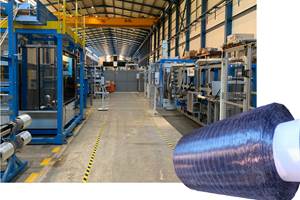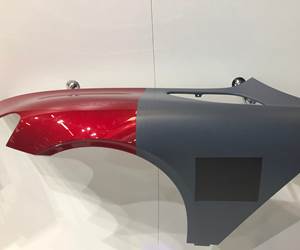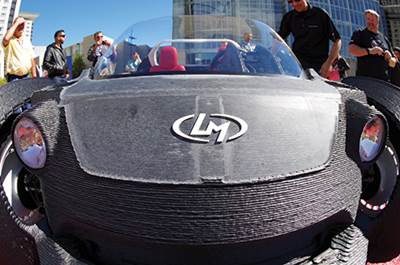Big Area Additive Manufacturing (BAAM): Increasing material feed and speed
Oak Ridge National Laboratory (ORNL, Knoxville, TN, US) and Cincinnati Incorporated (Harrison, OH, US) take steps to increase the laydown rate on their large-format, gantry-based thermoplastic composite 3D printer.
The Big Area Additive Manufacturing (BAAM) machine built by Cincinnati Inc. (Harrison, OH, US) to print Local Motors’ (Chandler, AZ, US) Strati two-seat electric roadster at the IMTS show this past September was capable of printing at roughly 17 kg/hr. It completed the five body parts for the car in 44 hours (see “Additive manufacturing: Can you print a car?” under “Editor’s Picks” at top right).
A key partner in this ongoing large-format 3D printing project, Oak Ridge National Laboratory (ORNL, Knoxville, TN, US) has developed a new extruder for the BAAM machine that can attain print rates of 45-68 kg/hr. However, says Dr. Lonnie Love, head of ORNL’s Manufacturing Systems Research Group, “if I want to increase the material flow, I need to be moving faster.” Cincinnati Inc. adapted BAAM from its CNC-controlled gantry laser-cutting platform, which features a linear speed of 5 m/sec. “At IMTS,” says Love, “we were just driving in first gear, with the nozzle tip moving at 0.05 m/sec to 0.08 m/sec. But we have a lot of room to develop. We can easily go 20-40 times faster and lay down that much more material, but I have to coordinate the gantry velocity.”
He gives the example of increasing print speed from 4.5 kg/hr to 17 kg/hr — which the team achieved just prior to the IMTS show. “Using the same diameter nozzle, my speed had to go from 25 mm/sec to 100 mm/sec because I was pushing out more material.” Like toothpaste from a tube, if forward motion is too slow, the bead being applied will bulge, yet moving forward too fast will cause the material to thin out.
Love concedes that flow control is extremely challenging and one of the areas ORNL and Cincinnati Inc. continue to refine. The latter has developed software that controls the BAAM machine movement in the x, y and z directions and adjusts to the material flow. Cincinnati Inc. marketing manager Matt Garbarino explains, “Melting the plastic and pushing it out of the extruder faster is what ORNL is developing, but we’ve then got to effectively manage optimizing flow with feed rate for different geometries.” Love and Garbarino agree that the task is to coordinate the feed rate with the gantry control system to match the volume of material being applied to produce a very fine, repeatable bead.
Love details another aspect of coordinating material flow with gantry movement. “Imagine you turn on a pump and material flows out. So we must turn on the pump 40 milliseconds before we move the gantry and, likewise, turn it off 40 milliseconds before we make a turn.” He also notes that if the gantry stops and lifts up, it pulls the print material with it, creating spikes, which can then damage the machine as they harden. “So we have a circular motion to swirl the material off to prevent tails.”
“If the normal 3D printer operates at 1 in3/hr [~16.4 cm3/hr],” proclaims Love, “we will soon be at 1,000 in3/hr [~16400 cm3/hr].”
Related Content
The lessons behind OceanGate
Carbon fiber composites faced much criticism in the wake of the OceanGate submersible accident. CW’s publisher Jeff Sloan explains that it’s not that simple.
Read MoreRecycling end-of-life composite parts: New methods, markets
From infrastructure solutions to consumer products, Polish recycler Anmet and Netherlands-based researchers are developing new methods for repurposing wind turbine blades and other composite parts.
Read MoreNovel dry tape for liquid molded composites
MTorres seeks to enable next-gen aircraft and open new markets for composites with low-cost, high-permeability tapes and versatile, high-speed production lines.
Read MoreThe state of recycled carbon fiber
As the need for carbon fiber rises, can recycling fill the gap?
Read MoreRead Next
Additive manufacturing: Can you print a car?
Collaborative demonstration dispels doubt about 3D printing’s disruptive potential for direct-to-digital manufacturing of just about anything BIG.
Read MoreModeling and characterization of crushable composite structures
How the predictive tool “CZone” is applied to simulate the axial crushing response of composites, providing valuable insights into their use for motorsport applications.
Read MoreCFRP planing head: 50% less mass, 1.5 times faster rotation
Novel, modular design minimizes weight for high-precision cutting tools with faster production speeds.
Read More

























